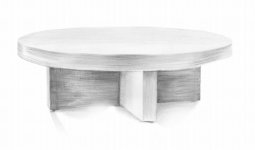Picture a lap joint for this design if one of the pieces decides to cup slightly over time. A simple lap joint makes it easy for the wood to move, and the glue joint between the side and end grain in the lap would be a potential point of failure. For the length and width of your pieces, I would not use a lap joint without modification. Here are some of suggestions for increasing the strength of the lap joint, if you decide that's still what you want.
(1) Put shoulders on the lap joints to make sure that all of the cut edges of the lap were captured tightly in the mating piece.
(2) Dovetail the shoulders to reduce the ways the wood can move even more.
(3) Cut 3" laps rather than 6" laps. One board would be 12" wide with 3" laps on each side. The other would be in two pieces for cutting the laps, each with a 3" lap. Once the laps are cut, sandwich the first board between the second two boards. (Use dominos to make sure the second two pieces are are lined up as precisely as possible when you glue them around the first piece, then scrape the joint smooth when dry.) Again, using shoulders to define the laps would increase the strength, as would dovetailing the shoulders.
Alas, no one would appreciate the design complexity of the joint you had cut without turning the table upside-down.
All of those suggestions are going to make the project stronger, but that comes at a cost. They all make the project more labor intensive, more complex, and more risky. If you have to make money on the project, or you have a short time to do it, then maybe you want to stick with the quicker options. But if you are doing it for the joy of it, and/or it's within your skill level, time budget, and risk tolerances, the extra work will result in a stronger table.
If you go the domino route (which I also like better than simple lap joints), I would still use shoulders on the joints to help with keeping the joints at 90 degrees and to make life easier for the dominos over time.






